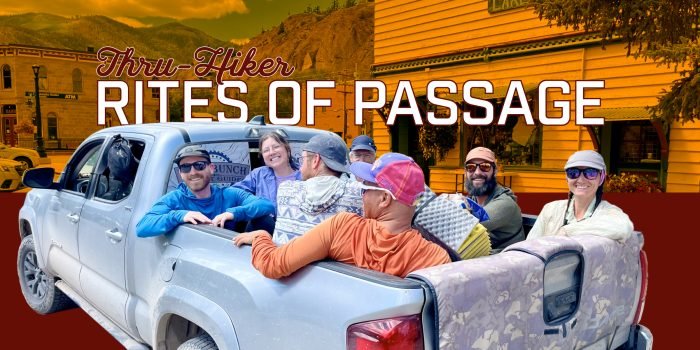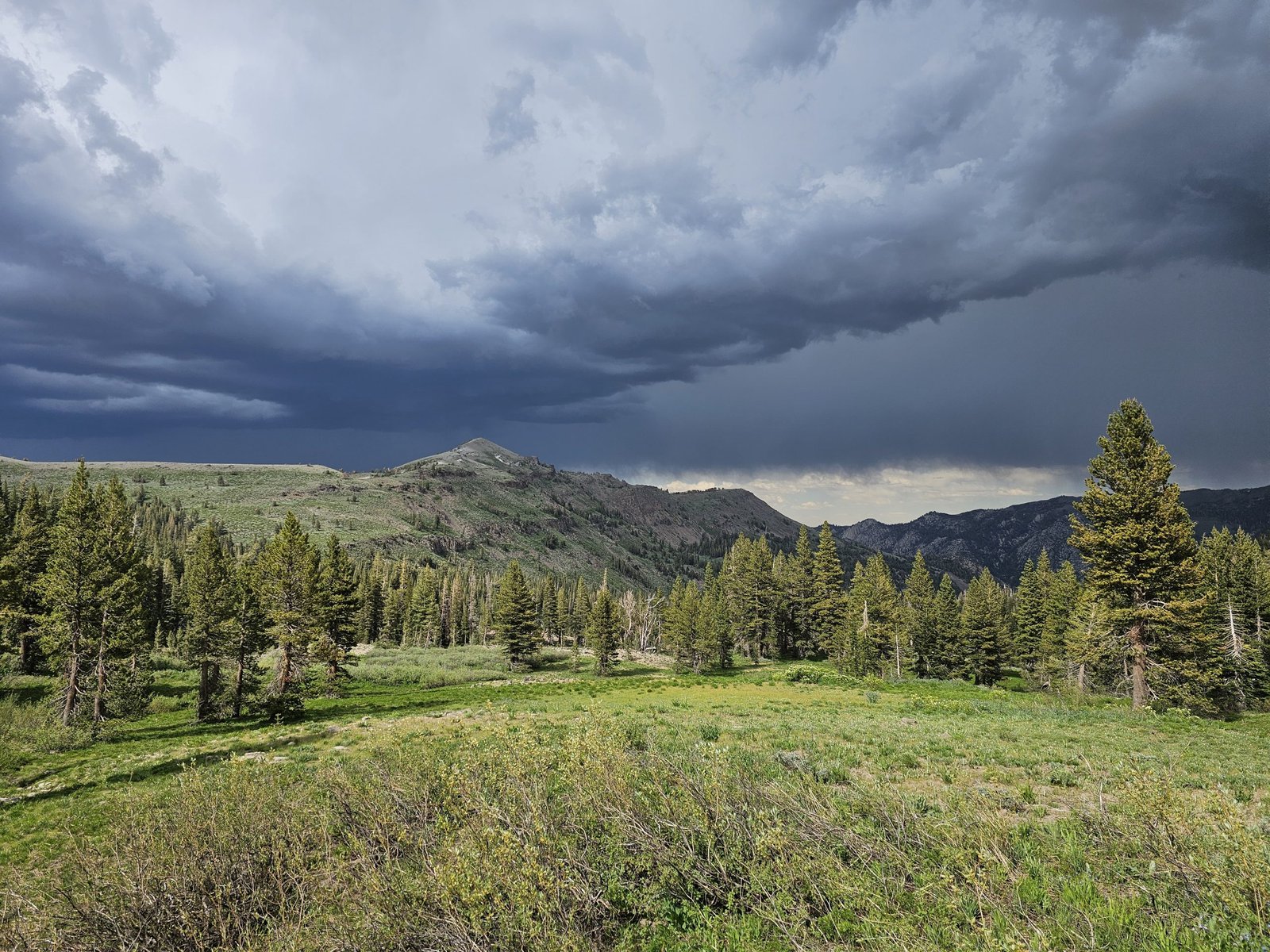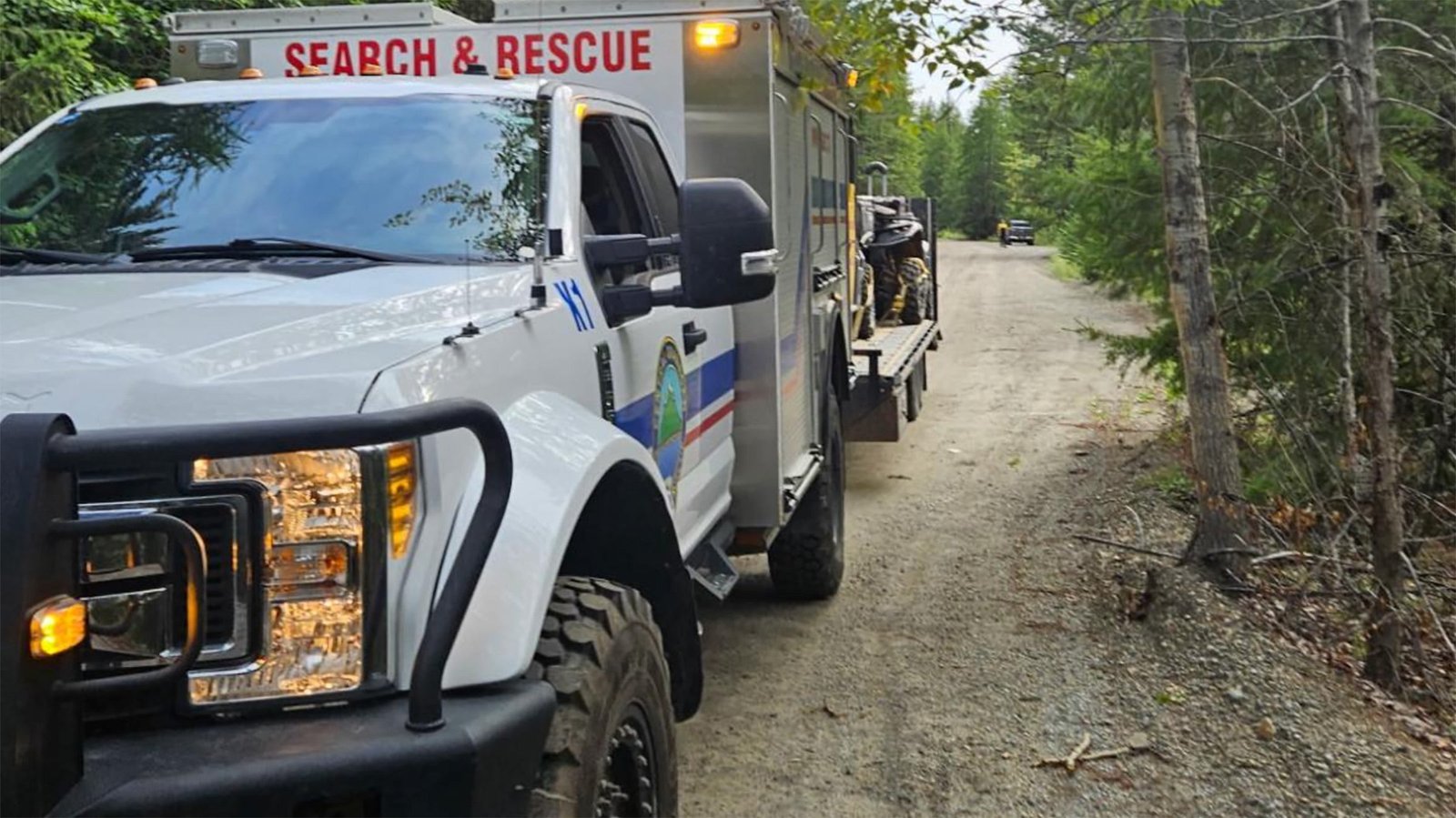Published August 4, 2025 11:30AM
Destinations & Things To Do
8 Rites of Passage Every Thru-Hiker Must Go Through

Thru-hiking is an intensely personal experience that means something a little different to everyone. No two thru-hikes are alike, and in reality there is no special ritual you have to go through to earn the right to call yourself a thru-hiker.
All the same, there are a few oddly specific, unifying experiences that almost every thru-hiker can relate to on some level. Some are goofy and charming, others are … less so, but they’re all quintessential aspects of long-distance backpacking.
How many of these thru-hiker rites of passage can you relate to?
1. Shitting Your Pants in the Mountains
You would be amazed by how many thru-hikers have shit themselves at least once on trail. If you see someone hiking in their rain pants on a sunny day for no apparent reason — trust me, there’s a reason.
Maybe it’s the intense exercise playing havoc with the gut microbiome or maybe it’s the large quantity of Spam Singles most thru-hikers ingest daily (or hey, maybe it’s giardia!), but this is a surprisingly universal experience for hikers.
All I can tell you is to carry imodium and don’t feel too bad about yourself if it happens.
This is a common, but admittedly not totally ubiquitous, thru-hiker experience. Here’s an alternative you might find more relatable (or be more willing to admit you’ve experienced): accidentally pooping in front of a traumatized group of day hikers because you didn’t realize the trail curves around to go right by your carefully chosen cathole site.
2. Sharing a Hotel Room With 1-5 Random Strangers You Just Met That Day
Jumping into bed with mysterious strangers you met in the forest two hours ago is generally a no-no. But for thru-hikers, it’s a budget-friendly way to enjoy a night in town.
Motels are expensive for one person, but if two or three hikers share a room, it can be the same price or cheaper than staying in a hostel, only with more peace and a private bathroom.
This is a lighthearted little post, but let me just state here that common sense still applies for thru-hikers, as much as we want to be silly and goofy all the time. Don’t do anything that makes you uncomfortable just because “all thru-hikers share hotel rooms.” Use your best judgment and listen to your gut.
3. Pushing Mega Miles Just To Prove You Can and Immediately Requiring a Double Zero To Recover
I could hike 20 miles per day and advance 60 miles toward my goal over the course of three days. OR, hear me out, I could hike 57 miles in one day just to see if I can and then spend two days horizontal in a hostel bunk recovering.
No shade on the latter strategy. For many of us, thru-hiking puts us in the best shape of our lives, and I understand the urge to push the boundaries a bit and see exactly how much our bodies are capable of.
For those who appreciate the finer things in life (and have the budget to support it), there is also something to be said for hiking big miles and balancing them with more time spent in town. I knew plenty of AT hikers who hiked like this — mostly men who were following this or that major sporting event and therefore needed regular access to trail town sports bars — and they all seemed happy enough.
Still, if you’re under time pressure, remember that consistency often counts for more than big-mile days. Hiking 20 miles per day and taking fewer zeros might get you to your destination faster than wearing your body down by busting out 35-mile days that leave you in need of more rest.
Your mileage may vary with this advice; if your name is Heather Anderson, for instance, you can disregard.
4. Experiencing Existential Dread Over Every Minor Ache and Pain
Every hiker is bound to get down in the dumps sometimes after stubbing their toe extra hard on a cunningly concealed rock or feeling a stubborn mystery pain in their knee. In the photo above, I lost my head completely after experiencing persistent foot pain and compensated by completely encasing both feet in gauze and leukotape, which is admittedly a) unhinged, b) a terrible strategy, and c) a waste of leuko.
Thru-hikers put so much of themselves into the trail — time, money, sweat, tears, hopes, dreams — and the thought of some meaningless freak accident ending it all in a split second is frankly terrifying.
Imagine planning your hike for years and making it a thousand miles down the trail before one badly placed step halts your lifelong dream in its tracks. This kind of thing can and does happen, and we all live with some level of anxiety over the possibility of a hike-ending injury. Every minor ache and pain can therefore feel like an existential threat.
The best things you can do for yourself on trail are to stretch daily, stay hydrated, rest often, wear good shoes, and generally listen to your body.
A certain amount of pain is normal when thru-hiking. It is a lot of wear and tear on the body, after all. But pushing through extreme, persistent pain is only going to make a hike-ending injury more likely.
5. Experiencing Existential Dread After Realizing You’re Eating 5x The Recommended Amount of Tuna
Single-serving tuna packets are widely available in most grocery stores and gas stations in the US and seem like a near-perfect hiking food. They come in lightweight packaging and add a punch of flavor and extra protein to your meals. As a result, they’re a staple in many hikers’ food bags.
But in the face of all these great reasons to eat tuna, it’s easy to forget that experts recommend limiting your consumption of tuna to just once per week, since ocean fishies higher on the food chain contain a lot of mercury. Convenient though they are, it’s probably best to lay off the tuna packs if you’re relying on them heavily.
Tuna Alternatives
Salmon packs are also fairly common. Salmon contains mercury but in lower concentrations than tuna, so the FDA recommends up to three servings per week.
Many grocery stores stock chicken packets in the same area, which could be a great alternative.
I hesitate to recommend Spam Singles as a healthier alternative to tuna because, well, you know. But if you’re a carnivore in search of single-serving, protein-rich flavor bombs, that is another option.
6. Hiking 1,500 Miles and Then Calling a Shuttle To Go 0.8 Miles to the Store
OK well first of all, zero days are meant to be rest days. Rest is good! We like rest. No shame in saving as much of your energy for the actual trail as possible.
And second of all, not all trail towns are walkable. Hiking on the shoulder of a busy, narrow road with fast-moving traffic is not the safest plan.
Even just half a mile can become an impassable distance if the shop or restaurant you want to visit is on the opposite side of a six-lane highway with no official pedestrian crossing.
One of the strange dualities of thru-hiking is that you come to love the feeling of traversing great distances but deeply resent the inconvenience of smaller journeys on foot.
7. Eating Hiker Box Mystery Powder
Is it whey protein? Mashed potatoes? Laundry soap? No one knows. But after perusing enough hiker boxes, your curiosity about the ubiquitous, unlabeled mystery baggies is bound to overwhelm your common sense — especially if you’re a hungry hiker on a budget.
Look, I can’t in good conscience recommend eating the unlabeled mystery powders. But if your heart is set on trying, maybe just give the contents a little sniff first and try preparing a small sample in town before adding the lot to your food bag.
Who knows, maybe you’ll discover your new favorite trail food. I sure did. (It was refried bean flakes, if you’re wondering.)
8. Hiking for More Than 1 Hour in the Wrong Direction, Crying
Generally this happens accidentally. But I did know one AT hiker who realized, 12 miles into his day, that he had left his Garmin inReach at the shelter that morning. So he hiked 12 miles back to retrieve it and camped at the same shelter that night, adding 24 miles to his legs but ending up no closer to Katahdin.
I love alpine starts when thru-hiking, but the combination of low visibility and sleep deprivation makes it all too easy to take a wrong turn early in the morning. The risk is highest when I’ve been camping a bit off trail. When I get back on the treadway, I now know I have to be extra careful to turn the right way.
My worst mix-up was on a predawn ascent of Mt. Washington. In the half light, I accidentally got onto a social trail where many hikers had cut a switchback. When it rejoined the AT, I accidentally turned the wrong way, never realizing I had briefly been off trail. I led my companions more than a mile back down Washington the way we had come up before realizing our (my) mistake.
Hiking the wrong way is a funny story after the fact, but it feels pretty darn bad in the moment, when you’re tired and hungry and just want to make forward progress. Take comfort in the knowledge that pretty much every hiker has done this at least once.
How Many Can You Relate To?
By no means do you have to experience all, or even any, of the “rites of passage” above to call yourself a thru-hiker. Much like getting a trail name, these are simply experiences many long-distance hikers share or can relate to. How many have you experienced?
Graphic design by Zack Goldman
Destinations & Things To Do
Brazil Travel Destinations 2025 : Culture, Nature & Authentic Experiences Lead Tourism Revival

The sun-drenched beaches of Rio, the thunderous roar of Iguaçu Falls, and the cobblestone charm of Gramado aren’t just postcard backdrops anymore. In 2025, Brazil’s tourism sector is surging back, driven by travelers craving immersive cultural exchanges and untouched natural wonders. Data from Embratur (Brazilian Tourist Board, May 2025) reveals a 34% year-on-year increase in international arrivals, with destinations prioritizing sustainability and local authenticity leading the resurgence.
Brazil’s Tourism Resurgence in 2025
Brazil’s 2025 tourism boom reflects a global shift: travelers now seek meaningful connections over superficial sightseeing. A recent Latin American Travel Association report (April 2025) notes 78% of tourists prioritize “cultural immersion” and “eco-conscious itineraries.” Rio de Janeiro exemplifies this, blending iconic landmarks like Cristo Redentor with new accessibility tech. Augmented reality tours in 15 languages now enrich visits, while safety upgrades have boosted family travel by 40%. Similarly, Foz do Iguaçu’s eco-revamp—including solar-powered boat tours and jaguar conservation trails—has made it South America’s fastest-growing adventure hub.
Top Brazil Travel Destinations for 2025
Rio de Janeiro remains unmissable. Beyond Copacabana, favela-led culinary tours and samba workshops offer raw cultural insights. Foz do Iguaçu leverages its “Three Borders” location for tri-national festivals, while rainforest lodges partner with Indigenous Guaraní communities.
Northeastern gems like Maragogi (Alagoas) and Jericoacoara (Ceará) dominate coastal searches. Travel analytics platform Kayak reports a 200% surge in bookings for Praia do Forte, where sea-turtle sanctuaries and capoeira classes redefine beach holidays.
Inland, Bonito (Mato Grosso do Sul) sets ecotourism gold standards. Government-mandated visitor caps protect its crystalline rivers, and certified guides lead cave-diving expeditions. Meanwhile, Gramado’s European flair peaks during its “Natal Luz” festival, now enhanced with AI-driven light installations and zero-waste initiatives.
Why Authenticity and Sustainability Drive Demand
Young travelers are reshaping Brazil’s tourism DNA:
- Eco-accountability: Bonito’s carbon-neutral certification (per Brazil’s Environment Ministry) has increased repeat visits by 60%.
- Tech-enabled access: Apps like “Brazil Offline” curate hyperlocal experiences, from Amazonian foraging trails to Salvador’s Afro-Brazilian cooking classes.
- Community-led tourism: In Paraty, UNESCO-listed historic tours now feature quilombola (descendants of enslaved Africans) storytellers.
Domestic demand is equally vital. Embratur’s “Viaje pelo Brasil” campaign has spurred a 55% rise in local bookings since 2023, with Northeastern states seeing record occupancy.
Brazil’s travel renaissance proves that destinations thriving in 2025 aren’t just scenic—they’re soulful. From the misty cascades of Iguaçu to Gramado’s alpine charm, Brazil travel destinations now marry spectacle with substance. As sustainability and storytelling become non-negotiables, the nation’s $50B tourism rebound (World Travel & Tourism Council, 2025) sets a global benchmark. Ready to explore beyond the obvious? Book your Brazilian journey through certified eco-operators today—adventure with purpose awaits.
Must Know
What are Brazil’s safest travel destinations in 2025?
Rio de Janeiro, Florianópolis, and Bonito lead safety rankings due to enhanced tourist policing and app-based emergency systems. Embratur’s real-time safety dashboard provides localized alerts.
Which Brazil travel destinations are best for families?
Gramado’s theme parks and Rio’s interactive museum tours top family lists. Praia do Forte offers kid-friendly wildlife programs, including supervised turtle releases.
How expensive is Brazil for tourists in 2025?
The strong dollar makes mid-range travel affordable. Expect $50–$80/day for meals and transport. Bonito requires bundled activity permits ($120/week), but these include guides and conservation fees.
What’s the best time to visit Brazil?
May–September (dry season) suits most regions. Avoid June crowds in Gramado during winter festivals. The Northeast shines year-round.
Are visas required for Brazil in 2025?
Yes, but e-visas for Americans/Australians process in 72 hours. EU citizens enjoy visa-free entry until 2026.
Which destination offers Brazil’s best ecotourism?
Bonito leads with government-enforced sustainability protocols. All operators must adhere to waste-reduction and wildlife protection standards verified by ICMBio (Brazil’s environmental agency).
Destinations & Things To Do
Ridgelines, Wet Electronics, and Thundering Downpours: PCT Days 90 to 93

In which our hero strives for lunch, dunks his electronics, and meets a friend.
The post Ridgelines, Wet Electronics, and Thundering Downpours: PCT Days 90 to 93 appeared first on The Trek.
Destinations & Things To Do
A Backcountry Singer Prompted a Search and Rescue Mission in Canada

A search and rescue team in British Columbia deployed drones, mounted police officers, and volunteers. They found a backcountry crooner.
(Photo: COSAR/Facebook)
When hikers reported hearing screaming in the woods near a popular climbing area in southern British Columbia, a local search and rescue team scrambled to respond.
It was the evening of Thursday, July 31, and the Central Okanagan Search and Rescue (COSAR) team was conducting a weekly training exercise when they received the distress call. According to a report on COSAR’s Facebook page, hikers told them that the yelling was coming from a wooded area near the Boulderfields, a recreation area south of the town of Kelowna.
The volunteer rescuer organization was able to respond in full force. As search drones took to the skies, a large team of rescuers, along with two Royal Canadian Mounted Police officers, began combing the woods to pinpoint the source of the screaming.
“Early responders even heard faint yelling—but couldn’t make out what was being said,” COSAR wrote. While half of the rescuers scoured the woods on foot, the rest drove nearby forest roads.
Then they found their supposed victim. Was it the survivor of a climbing accident? No. A moose attack victim? Nope. A selfie-taker who had fallen into a raging river? Nada. The terrifying screaming was actually coming from a solo camper who was, “singing his heart out to the trees, blissfully unaware that the acoustics of the Boulderfields had turned his tent-side concert into an accidental distress signal.”
“He wasn’t in trouble,” COSAR Search Manager Duane Tresnich said in the report. “Unless you count his singing.”
While the incident represented an unfortunate false alarm, COSAR said the hikers who called in the distress call acted appropriately. “That area’s full of tricky terrain and bike trails,” COSAR wrote, “so better safe than sorry.”
Screaming for help is often the best course of action for anyone experiencing distress in the backcountry, and multiple rescue operations suggest calling for help when other options fail. In mid-July, a critically injured solo climber in Washington was saved after nearby hikers heard him screaming across a valley.
But hikers and climbers should also be mindful that screaming or even singing in the backcountry can be misconstrued as a cry for help. So, the next time you want to do your best David Lee Roth impression on a hiking trail, perhaps keep the volume a few notches below your maximum.
“Remember, our services are always free,” COSAR added. “And the money you save could be spent on singing lessons.”
-

 Brand Stories2 weeks ago
Brand Stories2 weeks agoBloom Hotels: A Modern Vision of Hospitality Redefining Travel
-

 Brand Stories1 week ago
Brand Stories1 week agoCheQin.ai sets a new standard for hotel booking with its AI capabilities: empowering travellers to bargain, choose the best, and book with clarity.
-

 Destinations & Things To Do2 weeks ago
Destinations & Things To Do2 weeks agoUntouched Destinations: Stunning Hidden Gems You Must Visit
-

 Destinations & Things To Do1 week ago
Destinations & Things To Do1 week agoThis Hidden Beach in India Glows at Night-But Only in One Secret Season
-

 AI in Travel2 weeks ago
AI in Travel2 weeks agoAI Travel Revolution: Must-Have Guide to the Best Experience
-

 Brand Stories1 month ago
Brand Stories1 month agoVoice AI Startup ElevenLabs Plans to Add Hubs Around the World
-

 Brand Stories3 weeks ago
Brand Stories3 weeks agoHow Elon Musk’s rogue Grok chatbot became a cautionary AI tale
-

 Asia Travel Pulse1 month ago
Asia Travel Pulse1 month agoLooking For Adventure In Asia? Here Are 7 Epic Destinations You Need To Experience At Least Once – Zee News
-

 AI in Travel1 month ago
AI in Travel1 month ago‘Will AI take my job?’ A trip to a Beijing fortune-telling bar to see what lies ahead | China
-

 Brand Stories2 weeks ago
Brand Stories2 weeks agoContactless Hospitality: Why Remote Management Technology Is Key to Seamless Guest Experiences

You must be logged in to post a comment Login